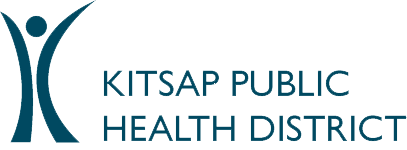ACTIONS REQUESTED
BE AWARE pertussis activity in Kitsap County and across Washington state remains high.
People at high risk for pertussis:
- Infants younger than one year or pregnant people
- Pregnant people in the last trimester (who will expose infants)
- Healthcare workers with direct patient contact (who may expose infants, pregnant people, or others who have contact with infants or pregnant people)
- Anyone who may expose infants younger than one year or pregnant people (e.g., childbirth educators, childcare workers, members of a household with infants)
CONSIDER pertussis infection in the following situations:
- Respiratory symptoms in infants younger than 12 months, especially if accompanied by difficulty feeding or apnea
- A cough illness, in patients of any age, that is characterized by one or more of the following:
- Paroxysms
- Gagging, post-tussive emesis, or inspiratory whoop
- A duration of 2 weeks or more
- Respiratory illness of any duration in patients who have had contact with someone known to have had pertussis or symptoms consistent with pertussis
IF YOU SUSPECT PERTUSSIS IN A PATIENT:
- Collect a nasopharyngeal swab for pertussis polymerase chain reaction (PCR) or culture. PCR is the most sensitive and fastest diagnostic test. Culture is the most specific option, but not the most sensitive, and is rarely done. Note that serology should not be used for diagnosing pertussis cases in Washington.
- A negative pertussis PCR or culture result cannot rule out pertussis. Treatment and case reporting may still be warranted, even with negative test results, per clinician’s assessment.
- CDC provides information about best practices for using PCR to diagnose pertussis.
- Report clinically suspected pertussis cases within 24 hours to Kitsap Public Health District. Call Kitsap Public Health 24/7 at (360) 728-2235 during clinical encounters with a suspected pertussis case. We will assist you in determining recommendations for prophylaxis and exclusion.
- Advise patient to stay home from work, school, or childcare. Advise them that they are considered contagious until they have completed 5 full days of appropriate antibiotics.
- Follow CDC’s detailed treatment guidance. Treatment is most effective if initiated within 1-2 weeks of symptom onset.
- Consider preventive antibiotics for the entire household if a member meets any “High Risk” criteria (above).
- Ensure children and adults are up-to-date on vaccine protecting against pertussis as recommended by national guidelines. Current vaccine schedules can be found on the CDC Immunization Schedules webpage.
- Prioritize vaccination of household members and other close contacts of infants.
- Tdap is recommended during each pregnancy after 20 weeks gestation (ideally during weeks 27 through 36).
Diagnosing pertussis can be difficult, particularly during the early (catarrhal) stage of illness, which features non-specific symptoms and may not initially include a cough. For a patient with respiratory symptoms, known or suspected exposure to pertussis should prompt inclusion of pertussis in the differential diagnosis.
The incubation period for pertussis ranges from 5 to 21 days. A key feature that distinguishes pertussis from other common respiratory illnesses is the duration of the cough (usually longer than two weeks and can last 10 weeks or longer).
BACKGROUND
Prior to the COVID-19 pandemic, Washington state typically reported between 600 – 800 pertussis cases during non-epidemic years, with higher transmission occurring every three to seven years. Similar to the rest of the United States, Washington experienced lower than usual pertussis activity during the pandemic (2020 – 2022), but now appear to be returning to prepandemic patterns. Since the beginning of 2024, there have been almost 3,000 laboratory-confirmed and epidemiologically-linked pertussis cases reported in Washington state, with the bulk of cases reported in the past six months. The highest case rates have been reported in children under 12 months, children aged one to four years, and adolescents aged 14 to 18 years. Counties in southwest and eastern Washington have been among those most impacted. During the 2012 pertussis epidemic in Washington state, there were a total of 4,916 cases, 105 hospitalizations, and one infant death.
Since October 1, 2024, there have been 53 laboratory-confirmed and epidemiologically-linked pertussis cases reported in Kitsap County, with around 75% occurring in school-aged children and adolescents. Kitsap Public Health has been working with schools and community organizations where cases have been identified to notify people at higher risk who may have been exposed, and to limit further spread in the community.
Vaccination for pertussis is recommended for persons of all ages in the U.S. and is critical to prevent severe illness in infants and young children. Around one in 10 Kitsap children entering kindergarten in September 2023 were not up-to-date on their pertussis vaccines. Vaccination of pregnant people is important to protect newborns and infants, and healthcare providers should strongly recommend and offer Tdap vaccination to pregnant people in the third trimester of each pregnancy regardless of prior vaccination history.
Weekly state surveillance updates are available online.
ADDITIONAL RESOURCES
- CDC’s Pertussis Clinical Features
- CDC’s Best Practices for Healthcare Professionals on the use of PCR for Diagnosing Pertussis
- CDC’s Administering Diphtheria, Tetanus, and Pertussis Vaccines
CONTACTING THE HEALTH DISTRICT
- Call: 360-728-2235 and leave a message. Includes reporting notifiable conditions 24 hours a day, 7 days a week. Leave the patient’s name, date of birth and disease.
- Fax: 360-813-1168
